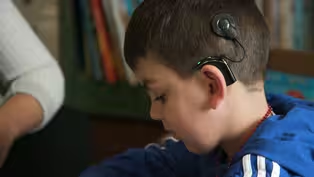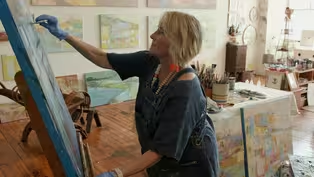
Green Seeker: Thrifty Business
Clip: Season 4 Episode 30 | 6m 57sVideo has Closed Captions
Thrift shopping is back in style—especially among the eco-conscious.
Thrifting is back in style, especially among young, environmentally-conscious Americans. As part of the continuing series Green Seeker, Isabella Jibilian goes behind the scenes at a textile recycling facility and meets unique individuals looking to make green the new black.
Problems playing video? | Closed Captioning Feedback
Problems playing video? | Closed Captioning Feedback
Rhode Island PBS Weekly is a local public television program presented by Ocean State Media

Green Seeker: Thrifty Business
Clip: Season 4 Episode 30 | 6m 57sVideo has Closed Captions
Thrifting is back in style, especially among young, environmentally-conscious Americans. As part of the continuing series Green Seeker, Isabella Jibilian goes behind the scenes at a textile recycling facility and meets unique individuals looking to make green the new black.
Problems playing video? | Closed Captioning Feedback
How to Watch Rhode Island PBS Weekly
Rhode Island PBS Weekly is available to stream on pbs.org and the free PBS App, available on iPhone, Apple TV, Android TV, Android smartphones, Amazon Fire TV, Amazon Fire Tablet, Roku, Samsung Smart TV, and Vizio.
Providing Support for PBS.org
Learn Moreabout PBS online sponsorship- [Host] Imagine what it would be like to not buy any new clothes.
- So in 2017, I got a striped shirt that was like I said like this is my last new thing I'm ever gonna get.
- That was the goal for Han Ray Yon, a student at Rhode Island School of Design.
He went nearly two years without buying a single new item of clothing.
What did you do instead?
- One like buying used.
So going through thrift stores, finding things, it's more based on like need rather than want.
So buying less and getting less.
- [Host] He also learned how to sew his own clothes, darn socks, and make his own repairs.
- I think you can see in the pocket here, like originally there's no bottom in the pocket so, - [Host] Jan says his new approach to shopping began when he saw how clothes were made and how it affects the environment.
- Huge amounts of water are used to like produce a single yard of fabric or especially in dyes and processing and agriculture too, like cotton is a pretty like water hungry plant.
- [Host] And he says not too many people know that polyester comes from drilling oil and synthetics shed.
- Fabrics make fuzz.
It's the lint that comes out in your dryer and from synthetic fabrics that's microplastics.
- [Host] One study found that a polyester garment can cast off more than 1900 fibers in a single wash, which then make their way through sewers and into waterways.
And Jan really reached a tipping point after seeing reports about the frequent human rights abuses when making fast cheap clothes.
In Bangladesh, environmental and labor laws are frequently ignored in the $1 billion export leather industry.
Wastewater with harmful chemicals is dumped into neighborhood streams.
The water seen here is actually dyed blue because of the process.
Workers process skins without protective gear, exposing them to known cancer causing agents like chromium.
And child workers are frequently seen operating heavy machinery.
Fast fashion also causes problems long after it's been made.
Author and journalist, Adam Minter has written about the global recycling industry for the past two decades.
- I mean, one of the things that's happened over the last 25 years really is that garments have become more difficult to recycle.
And that's where you start seeing large amounts of textile waste.
- [Host] And Minter says, this is why, in part, we're seeing a thrifting trend.
- Because of the development of, you know, of apps, the Poshmarks, the Thread Ups, you know, various other apps, eBay, people are able to post for sale their old garments straight out of their closet and they're purchased that way.
- If we have something and we love it, we'll wear it a couple times and then we'll sell it.
- [Host] 24 year old Jacqueline Jutriss uses Depop, a resale app that's a favorite among Gen Z.
- A lot of people selling clothing online starts with like the closet clean out, like for sure, that's where it starts.
You can put a towel over it and then just iron it quick, quick.
- [Host] Jutriss recently made her 700th sale on the platform.
- That's very sustainable in that, you know, it's all being purchased secondhand - [Host] Offline, Jutriss hunts for deals at the Goodwill Outlet in Hamden, Connecticut.
She calls it the bins.
Here, they sell by the pound and the more you buy the cheaper it is.
Every half hour, new bins roll onto the floor.
It's serious business for their main clientele.
Pickers, people who buy in bulk and resell.
- There should be no hands on the tables until the rotation is complete.
- [Host] Everyone has to wait for a signal before they can compete for the best clothes - All set?
- [Host] The leftover clothes head through the doors to Goodwill's Recycling Center.
They're tipped onto a conveyor belt, compressed into a thousand pound bales, and then stacked.
They might be shredded and used to stuffed cushions, cut into rags, or get exported abroad.
It's just a small slice of a global secondhand market.
- And there's all kinds of consumer survey data showing that younger consumers, Gen Z, starting with Gen Z, primarily, are open to this idea of use and reuse.
- [Host] But he says their excitement hasn't made a dent in the massive market for new clothes.
But some retailers like Patagonia and superstore, Walmart are listening.
They now offer secondhand on their websites.
- This is part of, you know, a massive consumer shift that's not necessarily going to happen overnight but I do think we are seeing a change where you are going to have secondhand used clothing as a bigger part of the overall apparel retail chain.
- What's your short take on what's the most responsible way to be a consumer of clothes.
- Buy secondhand, but when you buy new stuff, buy durability, stuff that can be reused that can feed that secondhand economy.
- [Host] Back at Rhode Island School of Design, Henri Jan continues to sew and thrift, but after nearly two years his strict, no new clothes streak came to an end.
- I think I broke it for dress socks actually.
- [Host] And socks weren't the only challenge.
- Underwear I, that was one of the things that did end the buying new clothes thing is getting new underwear.
- I don't think anyone blames me for that one.
- Yeah, so I'm definitely not so strict anymore.
Every once in a while, if I need something and I can't make it, or don't have the time to make it and can't find it and fit it and repair it, then I'll go and get something new.
So it's kind of like getting something new is the last resort if all my other things don't work out.
- Finally tonight, imagine living in a world where music
Video has Closed Captions
Clip: S4 Ep30 | 13m 5s | An in-depth look at how language deprivation can cause deaf children to fall behind. (13m 5s)
Video has Closed Captions
Clip: S4 Ep30 | 6m 46s | Those who have synesthesia say the way they view the world is unlike most people. (6m 46s)
Providing Support for PBS.org
Learn Moreabout PBS online sponsorship
- News and Public Affairs

Top journalists deliver compelling original analysis of the hour's headlines.

- News and Public Affairs

FRONTLINE is investigative journalism that questions, explains and changes our world.












Support for PBS provided by:
Rhode Island PBS Weekly is a local public television program presented by Ocean State Media

